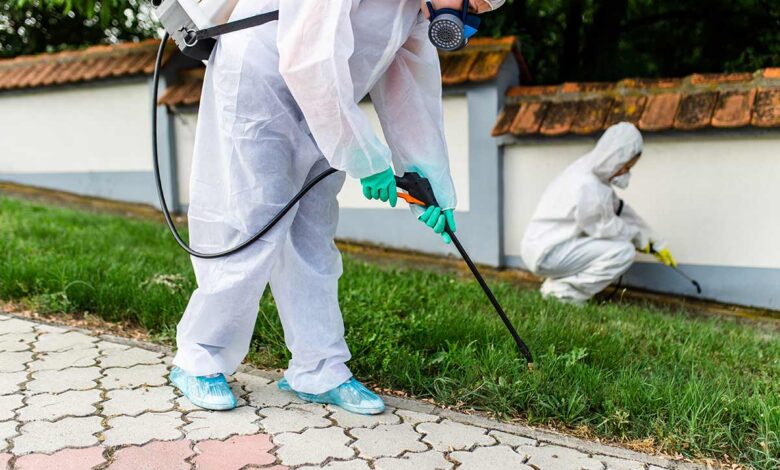
Table of Contents
ToggleIntroduction To Pest Control
Pest control is an essential aspect of maintaining a clean, safe, and healthy environment in homes and businesses. Whether you are dealing with common pests like ants, cockroaches, rodents, or more challenging infestations like bed bugs, understanding effective pest control strategies is crucial. This guide will explore the importance of pest control, the common types of pests, and focus on bed bug treatment, offering practical tips and strategies to eliminate these troublesome pests.
Understanding Pest Control
Pest control refers to the management and regulation of species defined as pests. These pests can be insects, rodents, or other animals that adversely affect human health, property, or the environment. Effective pest control involves several strategies that aim to prevent infestations, manage existing problems, and eliminate pests safely and effectively.
The Importance of Pest Control
- Health Risks: Pests can carry diseases that pose significant health risks to humans and pets. For example, rodents can transmit diseases like hantavirus and leptospirosis, while insects such as mosquitoes can carry viruses like West Nile and Zika.
- Property Damage: Pests can cause severe damage to structures, furniture, and personal belongings. Termites, for example, can compromise the integrity of wooden structures, leading to costly repairs.
- Food Safety: Pests like cockroaches and rodents can contaminate food sources, leading to foodborne illnesses. Effective pest control ensures that food remains safe for consumption.
- Quality of Life: Living with pests can be distressing and uncomfortable. Pest control helps create a peaceful and enjoyable living environment.
Common Types of Pests
Pests come in various forms, and understanding the types of pests you may encounter is essential for effective management:
- Insects: This category includes ants, cockroaches, termites, fleas, and bed bugs. Each type of insect requires a unique approach for control and elimination.
- Rodents: Mice and rats are common pests that can invade homes and businesses. They are known for their ability to reproduce quickly, making early detection and control vital.
- Birds: Some species of birds can become pests, particularly in urban areas. They can cause damage to buildings and vehicles and may pose health risks.
- Wildlife: Animals like raccoons, squirrels, and opossums can invade homes, often seeking food and shelter. They can cause damage and create hygiene concerns.
Focus on Bed Bugs
Among the many pests, bed bugs have become increasingly problematic in recent years. Understanding how to identify, prevent, and treat bed bug infestations is crucial for homeowners and renters alike.
What Are Bed Bugs?
Bed bugs (Cimex lectularius) are small, nocturnal insects that feed on the blood of humans and animals. They are typically brown or reddish in color, have flat, oval bodies, and can grow up to 5 mm in length. Bed bugs are most active at night and often hide in cracks, crevices, and bedding during the day.
Identifying Bed Bug Infestations
Identifying a bed bug infestation can be challenging, but several signs can indicate their presence:
- Bite Marks: Bed bug bites often appear as small, red welts on the skin, typically in a line or cluster. They may cause itching and discomfort.
- Blood Stains: Small blood stains on sheets, mattresses, or furniture can indicate bed bug activity.
- Fecal Spots: Dark, tiny spots on bedding or furniture are a sign of bed bug feces, which can be a key indicator of an infestation.
- Shell Casings: As bed bugs mature, they shed their exoskeletons, which can be found in hiding places.
Causes of Bed Bug Infestations
Bed bugs can be brought into homes and businesses through various means:
- Travel: Bed bugs are notorious hitchhikers. They can latch onto luggage, clothing, and personal belongings, easily spreading from one location to another.
- Used Furniture: Purchasing or acquiring used furniture, particularly mattresses and sofas, can introduce bed bugs into your home.
- Shared Living Spaces: Apartments and dormitories provide an ideal environment for bed bugs to spread between units.
Preventing Bed Bug Infestations
Preventing bed bugs requires vigilance and proactive measures:
- Inspect Secondhand Items: Before bringing secondhand furniture or clothing into your home, carefully inspect for signs of bed bugs.
- Travel Wisely: When traveling, inspect hotel rooms for signs of bed bugs. Keep luggage off the floor and consider using protective luggage covers.
- Regular Cleaning: Regularly vacuum your home, especially around bedding and furniture, to reduce the likelihood of a bed bug infestation.
- Seal Cracks and Crevices: Use caulk to seal cracks and crevices in walls, floors, and furniture to minimize hiding spots for bed bugs.
Bed Bug Treatment
If you discover a bed bug infestation, acting quickly and effectively is crucial. Here are some treatment options:
1. DIY Treatments
- Heat Treatment: Bed bugs cannot survive extreme temperatures. Washing infested bedding and clothing in hot water and drying them on high heat can effectively kill bed bugs.
- Vacuuming: Regular vacuuming can help remove bed bugs and their eggs from carpets, furniture, and bedding. Be sure to dispose of the vacuum bag immediately.
- Diatomaceous Earth: This natural powder can be sprinkled in areas where bed bugs are suspected. It dehydrates and kills bed bugs upon contact.
2. Professional Pest Control Services
While DIY methods can be effective for small infestations, larger or persistent infestations often require professional pest control services. Here are some common methods used by professionals:
- Insecticide Treatments: Licensed pest control professionals can apply insecticides specifically designed for bed bug elimination. These treatments are typically more potent than over-the-counter products.
- Steam Treatment: Professionals may use high-temperature steam to kill bed bugs in hard-to-reach areas, such as cracks and crevices.
- Fumigation: In severe cases, fumigation may be necessary to eliminate bed bugs. This involves sealing the entire structure and using gas to kill pests.
After Treatment: Maintaining a Bed Bug-Free Environment
After treating a bed bug infestation, it’s essential to maintain preventive measures to avoid re-infestation:
- Continued Monitoring: Regularly inspect your home for signs of bed bugs, especially in areas where you previously found them.
- Keep Clutter to a Minimum: Reducing clutter makes it easier to spot potential infestations and provides fewer hiding places for bed bugs.
- Educate Others: If you live in a shared space, educate your neighbors or housemates about bed bugs and encourage them to take preventive measures.
- Routine Cleaning: Regularly wash bedding, vacuum carpets, and inspect furniture to keep your home bed bug-free.
Focus on Bed Bug Treatment
Bed bugs are a growing concern in many areas due to increased travel and urban living. Their resilience and ability to hide make them particularly challenging to eliminate. Here’s how to effectively treat a bed bug infestation:
Step 1: Identification
The first step in bed bug treatment is confirming their presence. Look for:
- Bites: Red, itchy welts on the skin often indicate bed bug bites.
- Droppings: Small, dark spots on bedding or furniture can indicate bed bug activity.
- Shells: Shed exoskeletons may be found in areas where bed bugs hide.
Step 2: Declutter
Remove clutter from your home, especially around beds and furniture. This makes it easier to treat the area and reduces hiding spots for bed bugs.
Step 3: Washing and Drying
Wash all bedding, linens, and clothing in hot water. Dry them on the highest heat setting to kill any bed bugs or eggs present.
Step 4: Vacuuming
Thoroughly vacuum your home, focusing on areas where bed bugs are likely to hide, such as mattress seams, bed frames, and furniture. Dispose of the vacuum bag immediately after use.
Step 5: Treatment Options
- Insecticides: Use bed bug-specific insecticides available in stores. Follow the instructions carefully.
- Heat Treatment: Bed bugs cannot survive extreme temperatures. Consider using a steam cleaner on infested areas or hiring a professional who uses heat treatment methods.
Step 6: Monitoring
After treatment, continue to monitor for signs of bed bugs. Use bed bug traps to capture any remaining pests and ensure they do not return.
Preventing Future Infestations
To prevent bed bugs and other pests from returning, consider these tips:
- Travel Caution: When traveling, inspect hotel rooms for signs of bed bugs and keep luggage off the floor and bed.
- Regular Inspections: Periodically check your home for signs of pests, especially after guests have stayed or after traveling.
- Encasements: Use bed bug-proof encasements on mattresses and box springs to prevent infestations.
Conclusion
Pest control is an integral part of maintaining a healthy and safe living environment. Bed bugs, in particular, pose a unique challenge that requires attention and proactive management. By understanding the nature of these pests, recognizing the signs of an infestation, and employing effective prevention and treatment strategies, you can protect your home from bed bugs and other pests. If you encounter a significant problem, don’t hesitate to reach out to professional pest control services for assistance.
If you encounter persistent pest problems, especially with bed bugs, consider seeking professional assistance. With the right strategies and prompt action, you can ensure that your home remains pest-free, providing comfort and peace of mind for you and your family.
Investing time in pest control not only protects your home and health but also enhances your overall quality of life. By taking the necessary precautions and staying informed, you can enjoy a pest-free environment for you and your loved ones.





